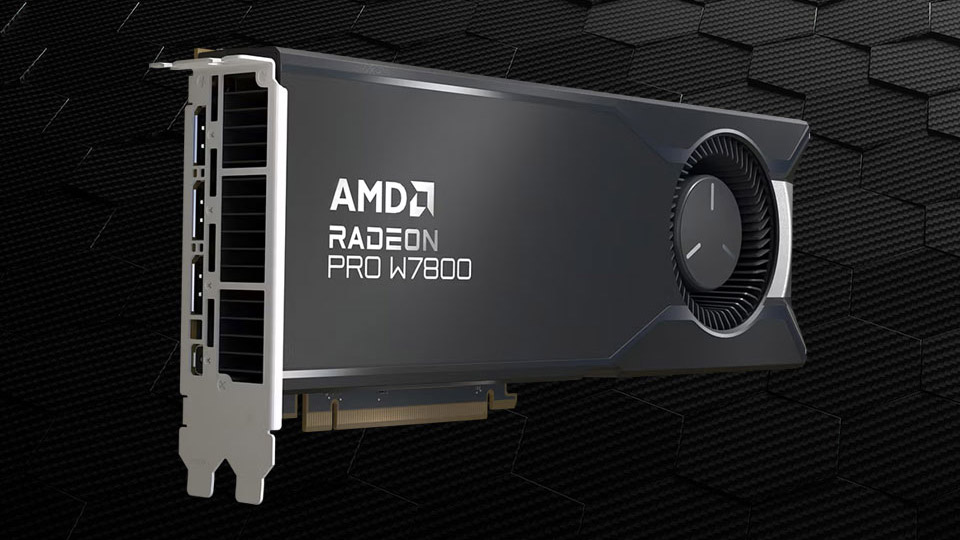While we wait for AMD's conspicuously absent RX 7800 XT, here's a simulated one
Where is the real deal?

AMD's Radeon RX 7900 XT and RX 7900 XTX made their debut in December 2022. They're high-end cards made with the most powerful RDNA 3 GPU: Navi 31. Flagship cards are always the first to release, and normally, the next GPU to be released would be one tier lower. Not this time, though.
The next card to be released was the Navi 33-based RX 7600, a full five months later than the RX 7900 cards. Where the heck are Navi 32-based RX 7800 cards? They remain conspicuously absent. There could be any number of reasons why. Maybe AMD isn't happy with the performance, or the GPU needed a re-spin, or there was some unexpected errata. We'll probably never know.
While we wait for Navi 32 cards, Igor's Lab undertook an interesting experiment. He took AMD's Radeon Pro W7800 graphics card, disabled half of its 32GB of memory and tweaked the power limits in order to simulate what to expect from a hypothetical RX 7800 XT.
Before looking at the results, it's important to remember that this is an experiment, and not one that claims to accurately simulate an RX 7800 XT. The actual specs of the Navi 32 GPU remain confidential, including the number of shaders, clock speeds and power levels.
Also, the W7800 uses the big Navi 31 GPU which it shares with the RX 7900 cards, making this very much an unscientific comparison. An appropriate amount of salt is required. Nevertheless, it's interesting, and a fun little experiment from Igor.
Looking at the results, we see the 'RX 7800 XT' is barely faster than the RX 6800 XT. It might be more power efficient, but without a decent inter-generational jump in performance, there would be few reasons to choose an RX 7800 card over a 6800 XT or 6900 XT for playing games.

We can expect the an RX 7800 to offer improvement in ray tracing performance, but that won't mean much if its raster performance isn't significantly better than the best RDNA 2 cards. Of course, AMD could sell the RX 7800 at an attractive price, though obviously it doesn't want to sacrifice its margins.
Keep up to date with the most important stories and the best deals, as picked by the PC Gamer team.
A rock and a hard place?

Best CPU for gaming: The top chips from Intel and AMD
Best gaming motherboard: The right boards
Best graphics card: Your perfect pixel-pusher awaits
Best SSD for gaming: Get into the game ahead of the rest
I spoke with a representative from an AMD partner at Computex. At that time they had yet to be informed of AMD's plans for RX 7800 or RX 7700 cards. That could have changed in the couple of weeks since, but as it stands now, I'm not expecting Navi 32 cards any time soon. If I had to look into my crystal ball and guess, I'd suggest a release in September or October would be likely, in time for Christmas.
AMD would surely like to have cards priced somewhere in the huge gap between the RX 7600 and the much more expensive RX 7900. I really hope an RX 7800 card can beat an RX 6950 XT and compete with the RTX 4070 and 4070 Ti at a good price. We need competition to bring prices down if nothing else!
We look forward to testing RX 7800 and RX 7700 cards if or when they do launch. Hopefully sooner rather than later.

Chris' gaming experiences go back to the mid-nineties when he conned his parents into buying an 'educational PC' that was conveniently overpowered to play Doom and Tie Fighter. He developed a love of extreme overclocking that destroyed his savings despite the cheaper hardware on offer via his job at a PC store. To afford more LN2 he began moonlighting as a reviewer for VR-Zone before jumping the fence to work for MSI Australia. Since then, he's gone back to journalism, enthusiastically reviewing the latest and greatest components for PC & Tech Authority, PC Powerplay and currently Australian Personal Computer magazine and PC Gamer. Chris still puts far too many hours into Borderlands 3, always striving to become a more efficient killer.

